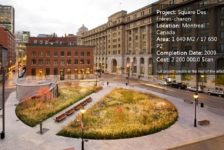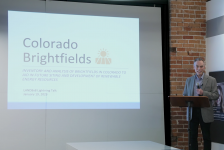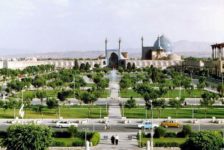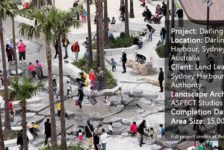Lyon is now famous among French landscape architects for The Rhône Riverbank redevelopment. Since 2007, a new walkway has replaced the long and dreary car parks, and is inspiring many cities throughout France to do the same with their own rivers. Designed in different height sequences, the varied landscapes allow nature to re-enter the city. The riverbank has multiple uses and is always crowded. The project managed to recreate the link between the inhabitants and the river, using the existing quay, levee and 19th promenade. ‘Bretillod’ is a word which means ‘damp environment subject to flooding and silting up’. This unpredictable landscape began the walkway. This is its wildest part, with sand banks and islands inhabited by many creatures including beavers. Sometime later, the bank becomes thinner, and the walkway is reduced to a pedestrian and bicycle alley lined by riparian trees. Shadowed by willows, poplars and alders, one may find a peaceful atmosphere as people pass through without haste. Between the very busy bridges ‘Morand’ and ‘Lafayette’, the bank was an unloading bay until the 1950’s. Numerous houseboats are still docked here, and so the walkway is as much a home as a recreational space. As a changeover between the country and the city, the seating and landscape details are definitively urban, made with high steel and wood, whereas the plants are still very rural (with hair grass, local trees species, etc.). The inhabited quay is continued by a long meadow, a crazy band of colorful flowers, crisscrossing with the bicycles, pedestrian lanes and recreational lawns. Here, boats house restaurants, nightclubs, etc. This part of the walkway is often crowded, so you might find it refreshing to get onto a café deck and stay a bit to admire the historical center on the other bank. At this point, kiosks were supposed to be built on the upper side of the quay, and house cultural activities and cafés, but this element of the plan was never realized. After that, one arrives at the center of the walkway. There lies a huge bench staircase opposite the most famous spot in Lyon: Fourvière. All is very rocky here, especially the huge skatepark, with some large trees to give shadow. Down towards the terraces, a ‘water mirror’ has been installed. The Rhône course is represented in its bottom. Children (and grown-up children) have much fun there in summer. South from the terraces, the 1960’s swimming pool still takes up much of the bank. A wood pontoon has been made for pedestrians, alongside the concrete bicycle lane, to link the other part of the walkway to the ‘university quay’. Being near the humanities faculty, the bank is mostly used by students for picnics, relaxation, revision, sports, games etc. A landing has also been built for scenic trips. As one moves away from the city center, the bank becomes once more wild, with Mediterranean plants recalling the sea not so far away… and one can continue the hike along the Rhône. Even before 2007, inhabitants used to came to the riverbank and walk, ride a bike or rollerblade between the cars of the parking lot. This is why this project is important: it takes a space made unifunctionnal (a parking lot near the river) and gives it back to people who has always felt that it was their place. Other riverbanks’ redevelopment are going on now in many French cities – Lyon, Angers, Paris, Bordeaux, Toulouse, Nantes, etc. – changing parking lots, abandonned industrial sites and speedways into parks. Project reported by guest writer Marie-Laure Séguin in collaboration with In Situ
This article was originally submitted to Landscape Architects Network
Published in Blog








